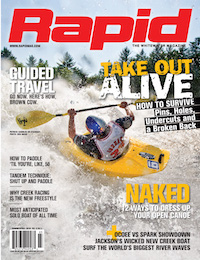For the past couple of years I’ve told anyone who will listen—and many who won’t—that racing is the next big thing in whitewater. There’s some irony in this. In a coming-full-circle kind of way, racing is where whitewater paddling started.
Don’t get me wrong. I’m not talking about the Kevlar, gates and Lycra shorts of the World Cup slalom genre. I’m talking about recreational racing, river running. Jump in whatever you paddle, start at the top and get to the bottom as fast as you can. In North America, this has been going on since the 1940s.
In The River Chasers (Sigel Press, 2001), Susan Taft chronicles the history of whitewater paddling and the development of river running. The earliest North American river running focused on exploration. The 1930s saw descents of most of the great rivers, including the Grand Canyon of the Colorado. Following these conquests, attention quickly turned from exploration to competition. For the next 50 years, from the Appalachian Mountain Club’s first downriver race in 1940 right up to the whitewater kayaking boom of the 1990s, racing was the epoxy that held the sport together.
The granddad of these competitions is Salida, Colorado’s FIBArk downriver race on the Arkansas, run continuously since 1949. In the 1950s, light-years advanced European racers were paid $300 each by race organizers to come to Salida and kick butt. They brought boats, river running skill and fitness as yet unseen.
Roger Paris, Walter Kirschbaum and Erich Seidel—all European champions—upped North American paddling to a whole new level. Legends such as Milo Duffek made extended stays and taught clinics. Paddlers from across the continent converged at FIBArk and went home amazed, armed with new techniques, boat design ideas and courage to push the boundaries. Even today, in the weeks leading up to the June festival, normally eddy-hopping Colorado playboaters can be seen blasting downstream on training runs.
“RACING BECAME A SUB DISCIPLINE OF SLALOM”
Whitewater racing’s first appearance at the 1972 Munich Olympic Games further rallied North American paddling around racing, but the Europeans proved far braver and more skilled on the manmade host course in Augsberg. North American paddlers returned home humbled yet determined to catch up.
It is at this point that racing became Kevlar, gates and Lycra tights. Downriver, or wildwater, racing became a sub discipline of slalom, even though it was the creator of it. Recreational boaters, uninterested in the precision required of slalom, went looking instead for un-run rivers and surf waves. Playboating was born. Where the Olympics were anticipated to be a boon to the sport, they more likely ostracised racing from the mainstream.
Racing as river running is back. With freestyle going the way of slalom as a specialty event, traditional river festivals looking for something new and more paddlers crossing back and forth between mountain biking, triathlons and other fitness sports, the timing is right. River running boats are back in style. Paddlers are revisiting classic runs to beat unofficial fastest times.
The Green River Narrows Race in North Carolina attracts 800 participants and spectators every November. This spring’s Hell or High Water race on the Petawawa River saw 106 racers, a 300 per cent increase in participants over last year. Events like this prove you can have the laidback, social atmosphere of paddling even with a stopwatch at the bottom. It becomes a great reason to get together. That is, after all, where whitewater paddling started.
Jef Jackson is a professor of Outdoor Adventure at Algonquin College in Pembroke, ON.




